If you’re like most people, you have many companies fighting for attention in your inbox. You might have dozens, hundreds, or even thousands of unread marketing emails that you have no plans to go back and revisit.
Of the marketing emails that you do read — what drives your choice to open and read those emails? A great relationship with the company that sent it? An interesting subject line? A hint that the content might be personalized to your interests as they pertain to the company in question? All three likely play a role in your decision to open and read the promotional emails that you receive, and personalization can help companies to improve on all three fronts.
Table of Contents
- Email personalization examples & best practices
- 1. Personalize based on buyer behavior
- 2. Optimize for mobile devices
- 3. Celebrate birthdays with special offers
- 4. Offer category-based discounts
- 5. Tell personalized stories
- 6. Make recommendations based on abandoned carts
- 7. Send out product updates and maintenance reminders
- 8. Personalize your own emails with an employee signature
- 9. Direct customers to content they’ll love
- Personalization is critical for success in email marketing
Check out this study from VentureBeat, which surveyed companies about how much personalization helped them to improve their open rates:
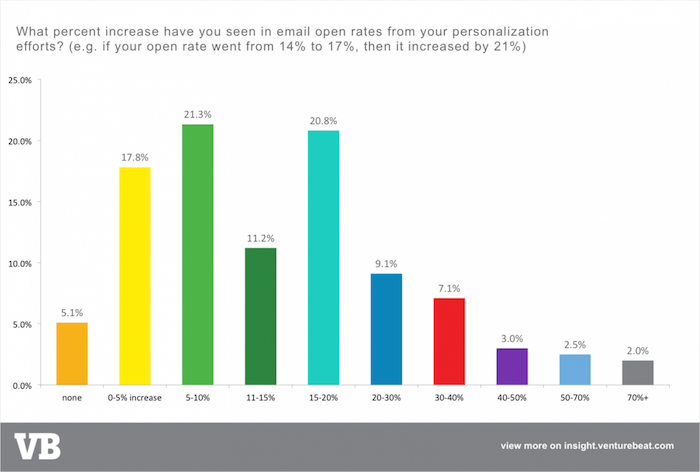
It’s easy to see why personalization might result in higher open rates. A personalized email delivers content that customers know will be more likely to be relevant to their interests. By definition, marketing emails that aren’t personalized just can’t make that same guarantee. Without personalization, you’re taking a shot in the dark regarding whether or not your intended audience will find your content useful, interesting, or intriguing.
Finding the right way to personalize your emails can be difficult. There is an unlimited number of ways to create more personalized content with a little creativity. Sadly, many companies end up following the standard personalization practices. Personalization can be so much more than “Hi [First Name].”
Let’s take a look at some of the ways that companies have found success with these email personalization examples.
Email personalization examples & best practices
1. Personalize based on buyer behavior
One of the most useful sources of data that you can collect for personalization comes from the behavior of your customers. Use the actions they have taken on your website or social media to inform your marketing campaigns.
In a recent survey from Ascend2, they asked marketing influencers about which personalization tactics they found to be the most effective for email marketing.
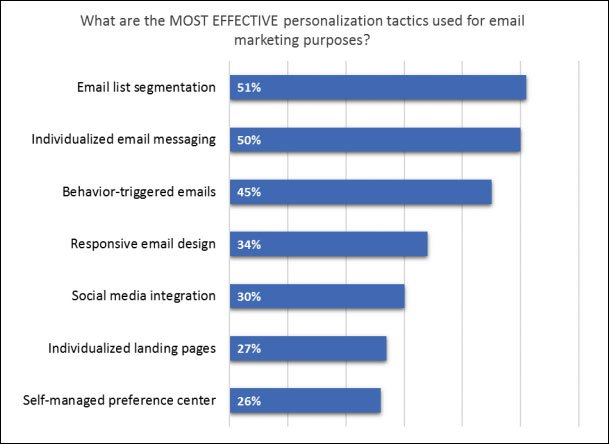
Near the top of the list, you’ll find trigger-based emails, named by 45% of respondents. Trigger-based emails are emails that are delivered when the customer takes a specific action on your website.
Some personalization examples of actions that might trigger email campaigns could include:
-
- Viewing a specific product
-
- A user doesn’t log in for a specific amount of time
-
- Signup up for your mailing list
-
- Abandoning a shopping cart
There is an unending number of “trigger events” that you can use to trigger the delivery of specific emails. Creativity here is important. Use your product, website, and analytics to determine the best times to send emails to customers.
Here’s an example of a trigger-based email from Black Milk Clothing. They send out an email at any time that a customer abandons their shopping cart with items in it. As a bonus, they use a cute dog picture to add a little more persuasion.
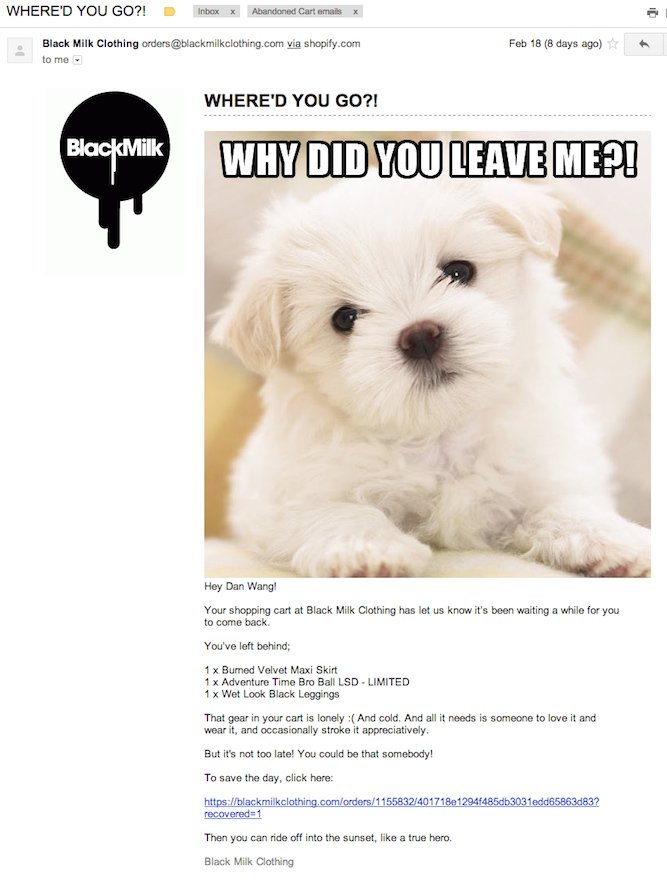
Using a customer’s behavior to trigger emails increases their relevance. The chances that the customer will open their email also rise. Deliver behavior-based emails while the actions are fresh in their minds.
2. Optimize for mobile devices
Did you know that most emails are opened on mobile devices? It’s not even close, in fact. Mobile dominates with more than 50% of opens. Webmail is sitting in the mid-30%, according to a 2017 study from Litmus Email Analytics.
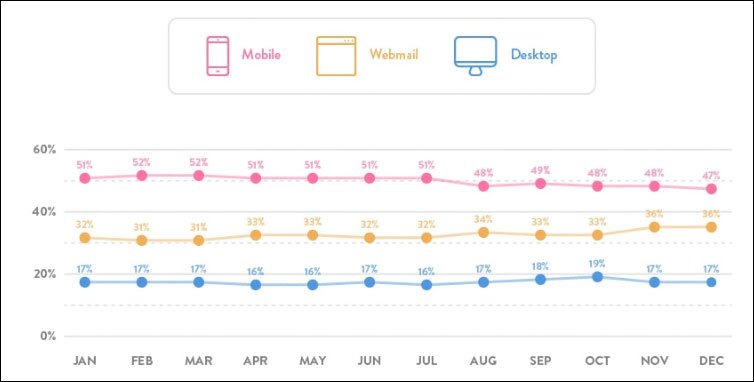
Despite this fact, many companies optimize their email campaigns for desktop and webmail users. They include too much text, too many images and a design that makes the emails difficult to load on mobile.
Take a look at this side-by-side comparison of a mobile-optimized email from Travel Pirates:

Their emails are simple and effective for responsive mobile browsers. Mobile users are able to view all of the information in the email. They don't need to change the basic layout of the information. The copy is kept simple and sparse. Images are kept to a minimum and easily loaded. Also, the images are not critically important to understanding the content, which is great as many email users will have images turned off in their settings for security reasons.
3. Celebrate birthdays with special offers
What could be more personal than wishing someone a happy birthday? There is something about remembering someone's birthday and sending something special their way that conveys that you care and they are important. Receiving a promotional email might not have as much weight as receiving a birthday gift from a friend. However, it does help to separate you from the competition and create a more personal relationship.
A great example of using birthdays to connect on a deeper level with customers comes from the Banana Republic:

By delivering a birthday gift in the form of a 15% discount, you convey that your customers mean something to your brand. According to a recent report from Experian, birthday emails are being opened 235% higher and click rates are 300% higher. Simply put, customers are more engaged with incoming messaging on their birthdays. You can miss an opportunity if you fail to send personalized promotional materials on this day.
4. Offer category-based discounts
ECommerce companies often find that their customers shop within specific categories. Sending a customer a discount coupon might, in some cases, be enough interest them. But you want to use the data that you have on hand to deliver discounts that are laser-focused on their interests based on what they have purchased or interacted with in the past.
Don't deliver generic coupons via email. Instead, focus on delivering coupons that target products you can reliably prove they have an interest in. By naming the category the discount applies to, the customer will think about which products they might be interested in using the coupon to purchase. The same can’t be said about more generic discounts and coupons.
Take a look at this example of category-based discounts that helped IncStores to grow their list by more than 300%:
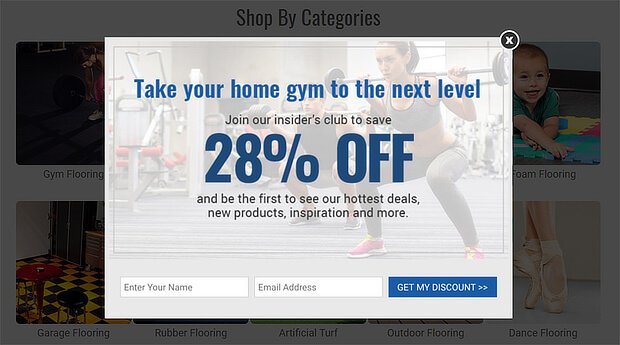
5. Tell personalized stories
There is nothing more personal to their customers than their own story. Finding ways to use their data to tell a personalized story can be a great way to connect them to your brand.
A great example of this type of email campaign comes from easyJet. They sent out an email to every customer that detailed everywhere that they had traveled with easyJet in the last 20 years. The emails struck a chord with their audience and reminded them of some of the best vacations that they had taken.
Here’s what the emails looked like:
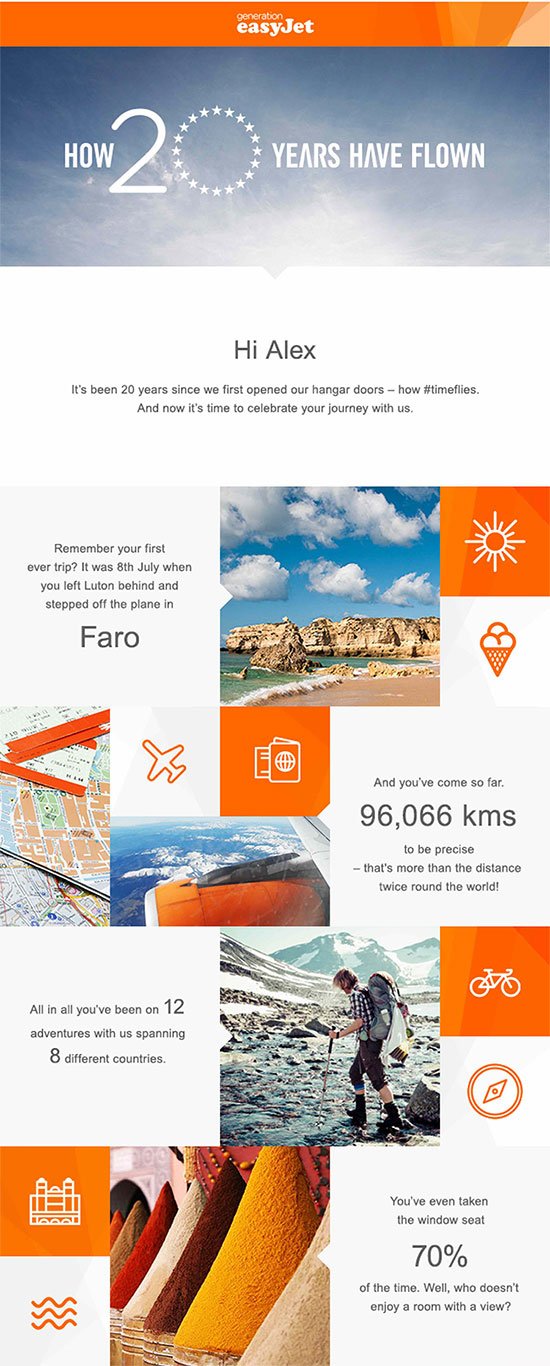
easyJet reported that their open rates for this campaign were 100% higher than previous campaigns. Using the data that you have to tell a story about a customer’s interactions with your company (especially when you can connect it to real-life events as is the case with easyJet), you make your brand synonymous and integral to those fond memories.
6. Make recommendations based on abandoned carts
A common eCommerce personalized email is the abandoned cart email. Essentially it is an email sent to any customer that abandons their shopping cart without checking out. An abandoned cart is a digital shopping cart that a customer filled with products but never completed checkout on. Personalization doesn’t have to be complicated. In the case of abandoned carts, it can be as simple as reminding them which products were added to their cart.
Mack Weldon takes the typical “abandoned cart email” a step further. They are recommending other products the customer may be interested in. Not only does this remind the customer that they never finished checkout, but it also increases the chances that they add other products to their order before placing it. Additionally, the customer could decide to remove the previous items in favor of the new items. Either way, it drastically increases the chances of a completed checkout.
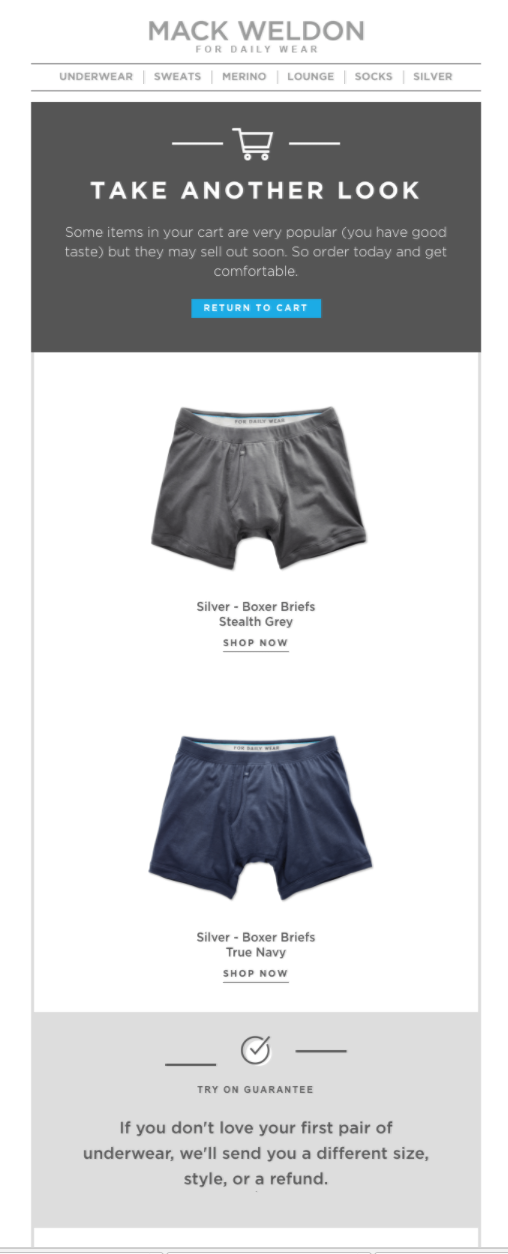
Take note of how the email also compliments the customer’s choice of product as well. It’s a subtle way to make them feel good about their decision to purchase the product while throwing some other ideas to them. Using your product recommendation engine to generate personalized recommendations will decrease cart abandonment rates while helping you improve average order value.
7. Send out product updates and maintenance reminders
When you sell expensive products that require manual maintenance (like vehicles or watches), a good portion of customers that purchase the product will completely forget to take the product back to receive the required maintenance. This is a big deal because, for some products, a failure to maintain it could completely diminish the value of the item or even void the warranty.
Reminding your customers via email about upcoming maintenance milestones can be a great way to foster engagement and loyalty. A great example of custom, personalized maintenance milestone emails come from Nissan. When a Nissan vehicle hits a milestone where maintenance is required, they send out an automatic reminder that prompts customers to take care of their vehicles.
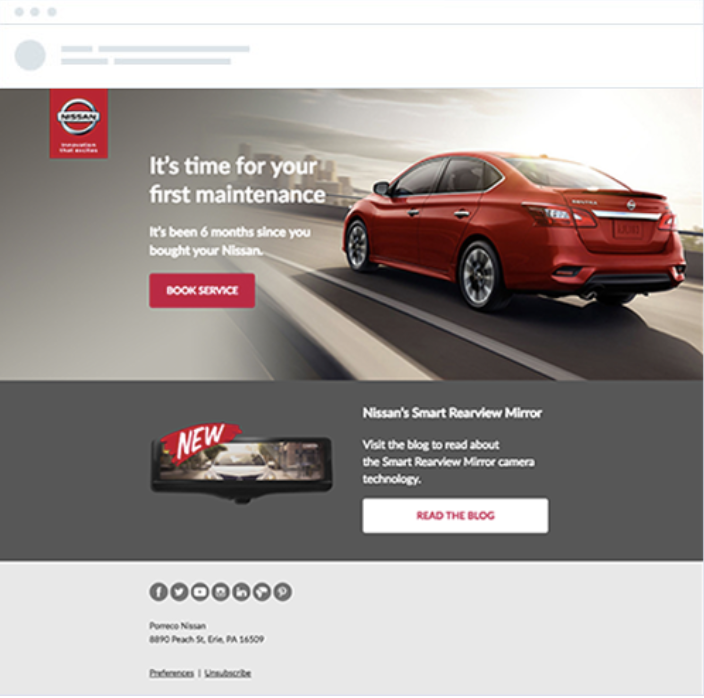
Simple reminders like this can have a huge effect on the customer’s view of the product. They’ll appreciate the reminder, but they’ll really appreciate the longer life of their vehicle. Car manufacturing companies live and die by the dependability of their vehicles. Taking the time to develop personalized email reminders for important maintenance milestones will increase customer satisfaction and improve the reputation of your products in the long term.
8. Personalize your own emails with an employee signature
When we talk about personalization in email marketing, we mostly refer to using customer data to deliver content that is relevant to their interests and experiences with your company. It’s an extremely valuable practice. However, we rarely talk about personalization on the other side — the company’s side.
People want to converse with real people when they receive marketing messages. Now, in the automated ecosystem of today, customers generally have to accept the fact that there really isn’t a person on the other side personally typing the emails that they receive. It’s expected. But, including a signature of a real person (with contact details that they can actually use to reach someone at your company) is a great way to increase the perception that there is a real person there sending them the materials that they receive from your organization.
Take a look at how HubSpot sends many of their marketing emails:
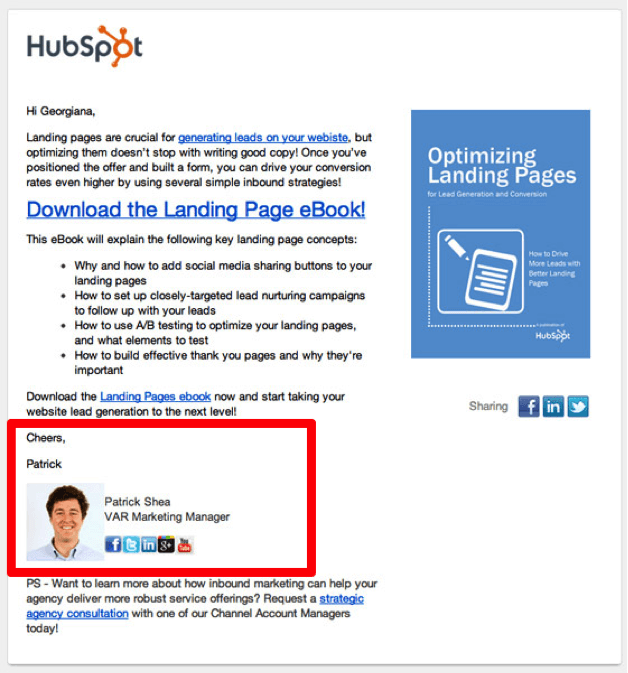
The company used real employee signatures as part of a split test and improved its click-through rate for this particular email from 0.73% to 0.96%, generating more than 250 additional clicks.
9. Direct customers to content they’ll love
If your company produces a lot of content, it might be hard for your customers to find something they like. No one wants to go through endless blog pages to find a few articles that will actually answer the questions that they have. Use the data that you have on hand to direct your customers to the best content.
Netflix is a great example of a company that offers more content than its customers can realistically consume. It’s impossible to watch everything in the Netflix catalog, and the company knows it. Their database can be overwhelming for their customers to sift through. As a result, they started sending out personalized emails that directed users toward content in their library that they will be likely to enjoy based on previous viewing habits.
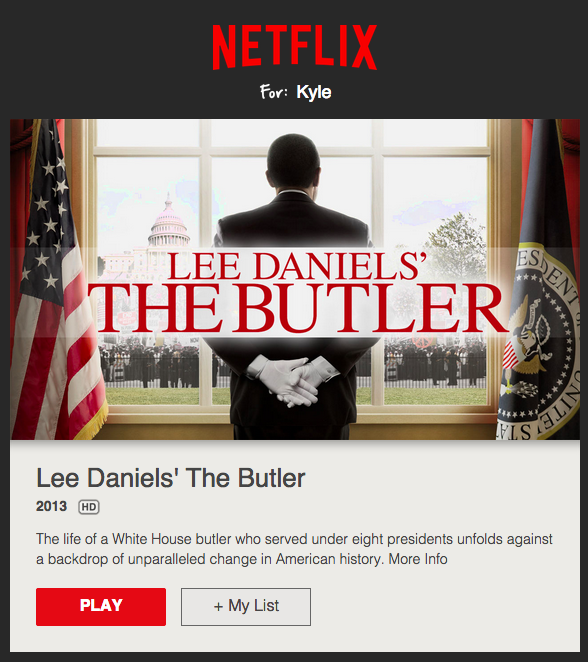
Don’t assume that your customers will be able to find the content that interests them. Use their behavior and viewing habits to guide your email marketing campaigns. You’ve already invested your time and money into creating the content. If you let it go to waste without reaching your intended audience, it won’t help you maximize your return on that investment. Using email to connect your audience with that content can be a great way to build lasting relationships.
Personalization is critical for success in email marketing
Personalization is absolutely critical for success in email marketing. Customers have started to expect that the brands that they interact with will be able to not only track what they do in the context of their company, but also use that data to understand their interactions and make better recommendations for products, content, and actions. The above email personalization examples and best practices show some creative ways that companies have used their data to improve personalization and facilitate better experiences for their customers.







